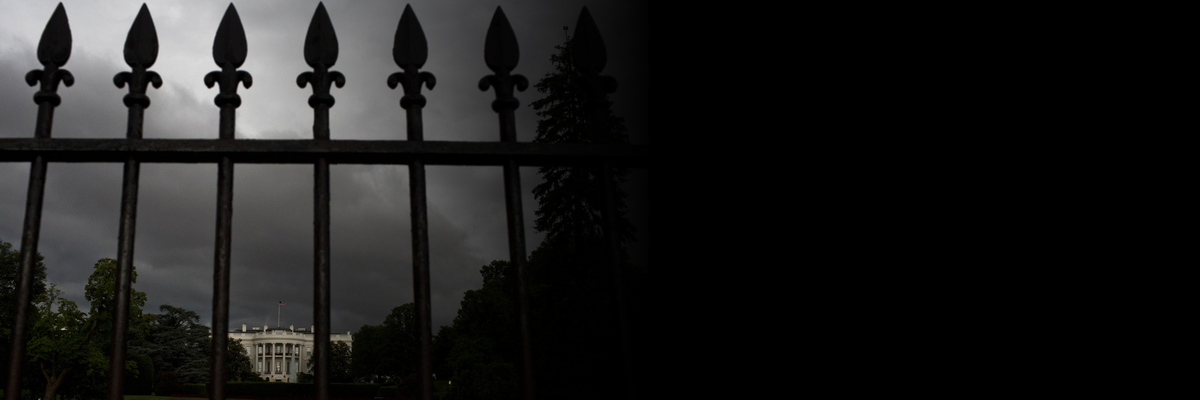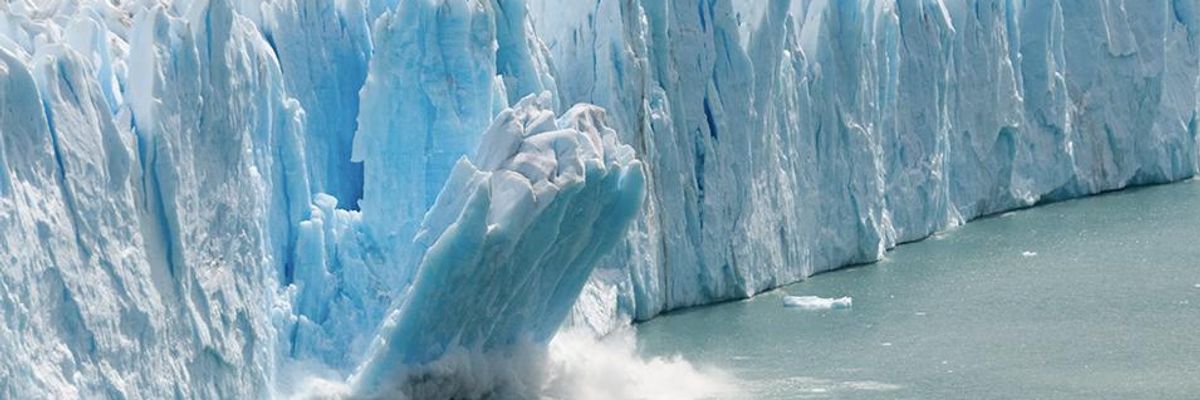As a new global-warming charged hurricane dumps historic amounts of rain over the Carolinas, reporting on climate change is seeing another uptick. However varied the predictions, there is one number that will always be included in the article: 2100 - as in the year 2100. Or sometimes just "by the end of the century."
Whatever level of frightful climate impacts are being envisioned, journalists, and the scientists they are reporting on, always feel compelled to tell us where things will be by 2100. Of course one year (or 100) is an arbitrary measure when it comes to the proceedings of nature - the planet is not punching a time clock, after all - but the problem with "2100" as a guidepost for climate change predictions goes well beyond that, and you don't have to be a scientist to understand it.
# # #
When we put carbon (and other greenhouse gases) into the atmosphere, it causes the atmosphere to retain more heat. Scientists can do the math on how much carbon we're generating and calculate (approximately) the amount of warming that will result.
But as we warm the atmosphere we also trigger natural processes on our planet that contribute even further to warming. They are called feedback loops, and they are very straightforward.
For instance, as the atmosphere warms up, the ice caps melt, and smaller ice caps mean less sunlight reflected back into space and more absorbed by blue water, as well as more methane (a greenhouse gas much more potent than carbon) released from the thawing seabed - all of which contribute to more warming. Warmer and drier conditions have also led to larger forest fires and a longer forest fire season - just ask anyone in California - and all that smoke leads to more global warming.
However, unlike manmade production of carbon and methane that can - in theory, anyway - be controlled, reduced or even eliminated, these natural processes, once triggered, reinforce themselves. A smaller ice cap means more warming... which means an even smaller ice cap than before, which means even more warming than before leading to even faster shrinking of the ice caps - and so on. The smoke from massive forest fires leads to even drier and hotter conditions, which creates even larger forest fires than before creating even more smoke than before - and so on.
Melting ice caps and growing forest fires are just the two most obvious feedback loops, but scientists have identified more. And they are now all in motion, reinforcing themselves and adding to global warming in ways we can only begin to imagine.
Global warming is not a linear process, it's a geometric one. It's an accelerating process. And science, for all its wisdom, has no way to measure that.
Scientists tell us what the planet will be like in 2100 based on their understanding of the linear process of adding X amount of carbon to the atmosphere. But have they figured in an Arctic ice cap that could easily be gone in five years, and the extra heating that will result? How about the methane rising from permafrost melting around the world? Do they estimate how much larger forest fires will be in 10 years, and the effect of all that extra carbon rising into the atmosphere?
Worse yet, how can one calculate the results of a process that is accelerating at an unknown rate - and that will be accelerating even faster next year as it continues to reinforce itself? The simple answer is you can't.
# # #
The challenge of making accurate predictions of climate change is not a secret. In 2012 Scientific America published an article noting of the Intergovernmental Panel on Climate Change (IPCC): "Across two decades and thousands of pages of reports, the world's most authoritative voice on climate science has consistently understated the rate and intensity of climate change and the danger those impacts represent." ("Climate Science Predictions Prove Too Conservative" December 6, 2012)
Yet most climate scientists, and the reporters that cover them, still have a hard time coming to terms with the existence of feedback loops, or including them in their discussions and predictions. A good example is David Wallace-Wells, who wrote a meticulously researched and much discussed climate change cover story for New York magazine last summer entitled "The Uninhabitable Earth," in which he outlined "worst case scenarios" for advancing climate change.
Wallace-Wells caught flak from parts of the scientific and activist community for being too pessimistic, even though his piece accurately portrayed what many scientists are saying. And even though his scenarios, while horrible, were not "worst case." Notably, he never discussed the possibility of extinction - even though it is commonly accepted in the biological sciences that we are already well into the sixth great extinction event in our planet's history. (See Elizabeth Kolbert's 2015 Pulitzer Prize-winning book, The Sixth Extinction, on the subject.)
Interestingly, and contrary to the widespread interpretation of his piece, Wallace-Wells pushed back against the "doomer" label he was given by some, and continued to cite "end of the century" predictions and how, given so much time, we could - and likely would - still avoid his worst case scenarios. He was still pushing the "2100" timeframe this summer in his article "How Did Climate Change Suddenly Become Old News"... although events now seemed to give him pause:
"Those worst-case scenarios are still quite unlikely, since they require both that we do nothing to alter our emissions path, which is still arcing upward, and that those unabated emissions bring us to climate outcomes on the far end of what's possible by 2100.
But, this July, we already seem much farther along on those paths than even the most alarmist climate observers -- e.g., me -- would have predicted a year ago."
Apparently the hottest July ever recorded on the planet, the largest forest fire in California's history, wildfires above the Arctic Circle, and biblical rain and flooding in Japan that drove more than a million people from their homes caught Wallace-Wells' attention. But these events came as no surprise to climate observers who have been paying attention to the feedback loops.
# # #
Finally, last month, a major new study emerged that challenges all our conventionally accepted predictions on climate change.
In a report published in the prestigious Proceedings of the National Academy of Sciences, 16 scientists warned that the IPCC's estimates of climate change might be greatly underestimated, based on - you guessed it - the existence and operation of feedback loops. Remarkably enough, the IPCC barely mentions feedback loops in any of its reports and predictions. Many scientists have already been critical of the Paris Accord goals (which are based on IPCC predictions) as insufficient, but now we have a group of scientists concluding that the IPCC estimates themselves are likely way off the mark.
Johan Rockstrom, executive director of the Stockholm Resilience Centre and one of the authors of the paper, describes the effects of feedback loops being like a row of dominoes: "Once one is pushed over, it pushes Earth towards another. It may be very difficult or impossible to stop the whole row of dominoes from tumbling over." The image of a runaway train was also invoked.
This dire imagery notwithstanding, the scientists writing this very disturbing paper felt compelled to include a note of hope and call to action - but as is often the case with such calls it sounds as if the scientists involved haven't read a newspaper in a while ... or perhaps believe in the societal equivalent of alchemy. "Collective human action is required"they note in the abstract summary. "Such action entails stewardship of the entire Earth System--biosphere, climate, and societies--and could include decarbonization of the global economy, enhancement of biosphere carbon sinks, behavioral changes, technological innovations, new governance arrangements, and transformed social values." And this all needs to be done more or less immediately, of course. Well, okay. But can we also try turning carbon into gold while we're at it? You never know, after all.
In his coverage of this new study, a somewhat chastened Wallace-Wells, while granting the validity of the science behind the report and the fact that these ideas have been discussed for a while (albeit on "the fringe"), makes sure to point out that this "Hothouse Earth" scenario is not inevitable. The very fact that these scientists are talking about "runaway climate change," though, suggests to him that "we should at least be worrying about the possibility. By which I mean: doing much, much more to halt warming in its tracks."
# # #
Perhaps scientists and reporters feel obligated to include rays of hope in their work on climate change to be absolutely factual - who knows exactly what the future holds, after all? - or perhaps because no one, including them, wants to consider the possibility of extinction, or be that depressed. Scientists have children too.
Or maybe they truly feel that their increasingly dire warnings, properly understood, will motivate people to action. "Yes, the prospect of runaway climate change is terrifying. But this dead world is not our destiny. It's entirely avoidable," meteorologist Eric Holthaus wrote in Grist, adding "... implying otherwise is the same as giving up just as the fight gets tough."
Maybe, although it's hard to see what "fight" we would be giving up. Even putting aside the maniacs currently running our country and their headlong rush backwards on climate, as someone who has a decent number of educated, informed and socially conscious and active friends, I can tell you I virtually never hear the words "climate change" in conversation, nor do I see any new initiatives or movements forming. It seems most people are not being galvanized to action by these increasingly dire warnings, but rather paralyzed with fear.
Whatever the reason for most people's lack of response to - or outright denial of -climate change, we will unfortunately have to continue this experiment in human behavior, because terrible climate news and equally dire warnings from scientists aren't about to stop. In the wake the ground-breaking study on the impact of feedback loops came another new report, "What Lies Beneath: The Understatement of Existential Climate Risk," by researchers with the National Centre for Climate Restoration in Australia; it argued that the existential threats posed by the climate crisis have still not penetrated the collective psyche of humanity and that nothing short of a war-time mobilization can stop climate change now. It was also reported in August that the oldest and thickest sea ice in the Arctic has started to break up - something that has never happened in recorded history. And now we more than a million people evacuated for Hurricane Florence.
It is reasonable to assume that the millions of people fleeing fire, flood, and other climate change-induced extreme weather around the world are not thinking much about the end of the century. Neither should you. What befell them could happen to any of us next.
And whether you think climate change is already a runaway train, or that it can still be "halted in its tracks," and whatever you believe you should do as a result of what you believe, you can stop worrying about 2100. The only moment we have to act is now.



